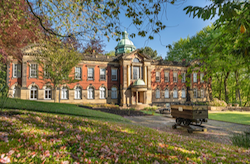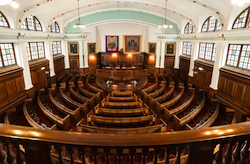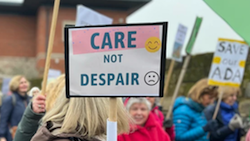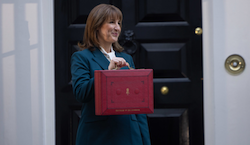Durham is known worldwide for its 900-year-old cathedral. But there is another historic building in the north-east city that holds a special place in the hearts of local people, one being reborn as a hub of heritage and hope for the county’s stricken communities. MARY STRATFORD explains.
Thursday 23 October 2025 is the 110th anniversary of the opening of the Redhills Miners’ Hall in Durham, home of the Durham Miners’ Association (DMA), site of the only parliament in England outside of London, and a building that stands as a testament to the power of collective endeavour and its ability to offer hope.
 It is fitting that the anniversary will mark the official re-opening of Redhills (pictured left) after a more than 10-year project to secure its future and restore the building as a centre for heritage, culture and education, paid for in part by £11 million in grants from the National Lottery Heritage Fund.
It is fitting that the anniversary will mark the official re-opening of Redhills (pictured left) after a more than 10-year project to secure its future and restore the building as a centre for heritage, culture and education, paid for in part by £11 million in grants from the National Lottery Heritage Fund.
The Redhills Appeal was based on a promise that ownership of the Miners’ Hall would pass to the coalfield communities of Durham, and the DMA honoured that pledge in 2021. Today the building is owned by the people of the county and stands as a symbol of hope in an otherwise bleak political landscape, embodying the living culture, values and histories of the area’s former mining communities, and of the union that represented the mineworkers.
The story of the DMA is a turbulent one, but it’s also a tale of togetherness, belonging and achievement. From its founding in 1869, the association fought passionately to improve the lot of its members and their families, not just the men’s wages and conditions, as important as they were, but people’s living conditions, their health and welfare, and, crucially, their right to vote.
The DMA’s goal was a just society where everyone was valued and cared for. It embraced international solidarity, offering support to others in struggle across the globe, and in turn received support from abroad when it was needed.
Out of necessity, the union helped forge a local civil society in which communities looked out for each other, cared for their neighbours and sought to educate themselves. Its motto – ‘the past we inherit, the future we build’ – is as relevant in 2025 as it was in 1869, perhaps more so.
While many of the association’s decisions and initiatives were sanctioned by men, who represented the miners’ lodges at the hall’s ‘Pitman’s Parliament’, it was in the communities where they were implemented. Many of the social improvements, and much of the DMA’s hard-fought-for political power, was only possible due to a legion of women activists (wives, mothers and daughters) who emerged, first through the co-operative movement and the ILP in the late 1800s, and then from the ranks of the Labour Party during the 20th century.
Living culture
For those of us involved in the Redhills restoration project, the anniversary and reopening on 23 October is the end of a long, hard struggle to save the building. But it’s also the start of a new journey towards a better future, built on, and inspired by, the values embodied in the hall and its people, ones of solidarity, equality and social justice.
 For Redhills is not a place for nostalgia. During our consultations with the people of county Durham, it became clear they didn’t want their history encased in a museum. They wanted a living, contemporary embodiment of their culture and achievements.
For Redhills is not a place for nostalgia. During our consultations with the people of county Durham, it became clear they didn’t want their history encased in a museum. They wanted a living, contemporary embodiment of their culture and achievements.
So the restoration project has never been merely about the building. Its aim was always to take inspiration from past achievements and translate them into initiatives relevant to today’s difficult political landscape. If there was ever a time the values of the DMA were needed, it is now.
The building is, of course, a central part of the plan and we hope the Pitman’s Parliament (pictured above) will be a meeting place for communities and groups to plan and organise mutual support projects. We also hope to inspire visitors with the story of the union and the communities it served.
But we’re looking beyond Redhills too, aiming to develop a solidarity economy in the former mining towns and villages of the county, where we hope to address the challenges they face and find a way forward. In other words, we aim to help them help themselves – exactly the model used by the DMA, which loaned funds to build facilities such as village welfare halls and parks. These loans would be paid back quickly and collectively by the community.
In some ways, our aim is to create nothing less than a commonwealth of coalfield communities, with co-ops and social enterprises at their heart, and with a focus on their priority issues of housing, social care and energy. Our first task, inevitably, is to raise funds and we’ve set ourselves an initial target of £5 million.
Undoubtedly, our plan is bold and ambitious, and not without risk. But if Redhills and its communities do not grasp this opportunity, who will?
As I write I am struck by how much this project has lifted my spirits over recent months as plans have begun to take shape and we’ve moved closer to the building’s reopening. All of us need hope, none more than those living in the former mining communities of county Durham.
The work I have been doing as a trustee of the Redhills charity gives me hope that by working collectively we can again effect change. My inspiration comes from those who went before, from their remarkable achievements, which came at times, much like today, of political turbulence and economic uncertainty. Truly we stand on the shoulders of giants.
—-
Mary Stratford is a trustee of the Redhills Community Interest Organisation, a charity that serve as stewards of Redhills’ heritage on behalf of Durham’s coalfield communities.
More about Redhills, its history and the project to create a solidarity economy is here.
You can find a film about the project here.


